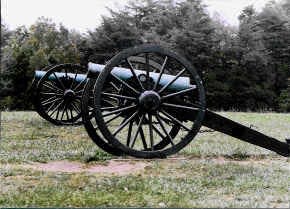Harry Bulkeley: Civil War battlefields terrible feeders for cemeteries
- Oops!Something went wrong.Please try again later.
- Oops!Something went wrong.Please try again later.
- Oops!Something went wrong.Please try again later.

It was just a cornfield. It didn’t look any different than a thousand cornfields we’ve seen in Illinois. Except this field was in Virginia. And it had a name — Slaughter Pen Farm. Standing on a small rise in the middle of the tract and looking around at the green shoots emerging from the soil, it’s not clear why this pastoral place would have such a grisly name, until you learn what happened here.
This was a battlefield in the Civil War. It wasn’t a famous battle like Gettysburg, but if you have studied the war, you know the name Fredericksburg. It is a town between Washington D.C. and Richmond, Virginia, where several major struggles occurred during that terrible time in our nation’s history. Within a few miles of this place Ulysses Grant and Robert E. Lee and Stonewall Jackson forged their reputations and thousands of Americans died.
Slaughter Pen Farm was one of those places. In December, 1862, 8,200 Union soldiers crouched on one side of this field. On the other side 38,000 Confederates waited for them to come. When they did, 56 Rebel cannons opened up accompanied by the crack of 38,000 muskets. The field was so muddy that it sucked the shoes off the men who advanced in wool uniforms soaked by a cold December rain. When the shooting stopped, the Union had suffered 5,000 casualties. Five Congressional Medals of Honor were awarded for bravery that day.
Others are reading: He had roles in 'Psycho II,' 'M*A*S*H,' 'Columbo' and many more ... and he's from Galesburg

It is hard to grasp the losses in the Civil War. In terms of numbers, there were twice as many casualties in the Slaughter Pan as there were on Omaha Beach. Between 600,000 and a million Americans died in the Civil War which is greater than any other war in our nation’s history. The casualty rate was over 2% of the entire population. If we were to suffer the same percentage of casualties today, it would be over 6 million people killed.
With those losses, it’s understandable why the Civil War left such a huge scar on our nation. It is the reason people felt a need to remember those losses and so began the Memorial Day holiday. Before the holiday became official, families, especially in the south, would go out in the spring to clean up and decorate the graves of the fallen. In 1868, General John A. Logan, a fellow Illinoisan, declared May 30 to be a day to remember the soldiers who perished in defense of their country. One reason for the date is that it is not the anniversary of any major battles during the Civil War. A national ceremony was held at Arlington cemetery and there were local events all over the country, north and south.
Battlefields like The Slaughter Pen were the terrible feeders for cemeteries all around the nation. Cemeteries like the ones people will be visiting this Memorial Day weekend. Burial grounds are sacred places but, as Abraham Lincoln said of the Gettysburg battlefield, “We cannot dedicate, we cannot consecrate, we cannot hallow this ground. The brave men living and dead who struggled here have consecrated it far beyond our poor power to add or detract.”
Battlefields are hallowed ground and I was able to walk across The Slaughter Pen because I am a member of the American Battlefield Trust. It is an organization that buys and preserves battlefields in the United States whether from the Revolutionary War, the War of 1812 or the Civil War. It is a cause that I am glad to support. When the Trust bought the Slaughter Pen Farm, it had to borrow most of the $12 million purchase price. They have been paying it off for several years but, with the donations of members, may finally pay off the loan this year.
Downtown Galesburg: Harry Bulkeley: New library our chance to leave a legacy
The Battlefield Trust (Battlefields.org) was organized about 40 years ago as a way for private citizens to contribute to saving our nation’s history. Since its beginning, more than 55,000 acres have been protected. In Princeton, New Jersey, the only battlefield where George Washington actually led the charge has been preserved.
Places have been saved at Manassas where the war began and Appomattox where it ended. Sites of little known battles from the Revolution and the War of 1812 have been acquired.
Cemeteries are the physical reminder of the sacrifice that American warriors made on battlefields in our country and around the world. Those fields must be preserved so we can honor their legacy. Why we preserve them was best summed up by Joshua Lawrence Chamberlain, a hero of Gettysburg.
Galesburg in 1976: Harry Bulkeley: Time traveling back to 1976 in Galesburg
"In great deeds something abides. On great fields something stays. Forms change and pass; bodies disappear, but spirits linger, to consecrate ground for the vision-place of souls. And reverent men and women from afar, and generations that know us not and that we know not of, heart-drawn to see where and by whom great things were suffered and done for them, shall come to this deathless field to ponder and dream; And lo! the shadow of a mighty presence shall wrap them in its bosom, and the power of the vision pass into their souls."
Harry Bulkeley is a retired Knox County judge and a local historian.
This article originally appeared on Galesburg Register-Mail: Harry Bulkeley: Civil War battlefields terrible feeders for cemeteries
